

Could green stimulus drive reflation? We think looser fiscal rules or conventional ECB action to reflate Europe are less likely, but see a potential 40bp of upside from a greener Germany and the Green New Deal.
Conventional fiscal stimulus or action led by a green ECB seem unlikely… In the euro area – although we see some upside risks – our base case has modest growth, inflation below target and the ECB on hold over our forecast horizon. With the ECB having limited scope to add further monetary stimulus, some have looked to fiscal stimulus to reflate Europe. But this appears challenging: many euro area countries do not have the ability in the current fiscal framework to add fiscal stimulus, agreement on meaningful euro-level fiscal capacity still seems far off, and the surplus countries with headroom, principally Germany, while they are financing some modest incremental easing (together amounting to ~0.4pp of euro area GDP) look unwilling to add substantial fiscal stimulus.
MS base case: Sub-par Europe with inflation below target
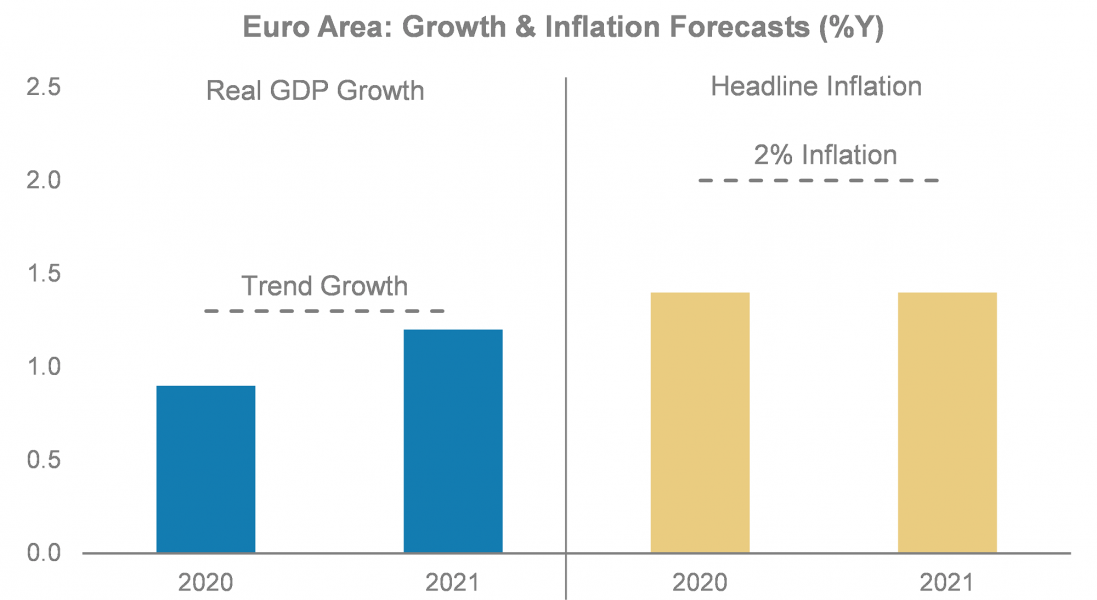
Source: Morgan Stanley Research forecasts
…but green stimulus looks palatable: The new leaders of the Commission, European Parliament and ECB are committed to tackling climate change. In particular, the European Commission has presented and the Parliament has supported in principle a Green New Deal, which aims to finance at least €1 trillion of investment over the next 10 years to tackle climate change. This highlights the possibility that decarbonisation could drive a policy shift and reflation in Europe (“greenflation”), much as our equity analysts see decarbonisation as a secular theme likely to drive markets. We estimate that this could add 25bp to EU growth, by increasing public and private sector investment.
The EU’s carbon targets imply a step increase needed in action to decarbonise
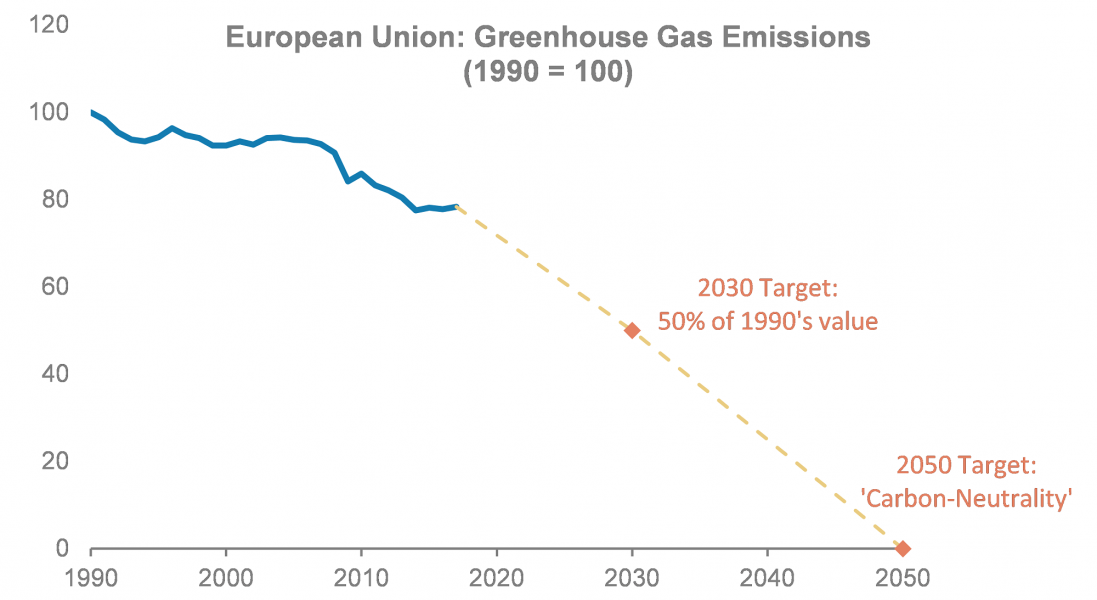
Source: European Environment Agency, European Commission, Morgan Stanley Research
Some greenflation options: We look at four green stimulus options, in what seems to us rising probability of impact. First, adjustments to the fiscal framework to allow additional borrowing to invest in green projects. Second, ECB action to incentivise green activity. Third, a green shift in German politics, which could open the door to a 1% of German GDP increase in green investment. Fourth, use of government guarantees – a key financing mechanism in the Green New Deal – to accelerate expansion of green projects, now that new renewables are broadly cost competitive with fossil fuels.
40bp upside risk to growth: Overall, the emerging green push highlights upside risks to growth, since greener policy is likely to drive higher investment, with a high multiplier effect on near-term growth, and a possible positive impact longer term on productivity. The scale and timing of greenflation remains unclear: we are sceptical that the EU would loosen the fiscal framework or that the ECB would play a leading role. But we see about 20bp of upside risk to EU growth if Germany pursues green stimulus, and about 25bp of upside risk to EU growth from the Green New Deal. Given some potential overlap, we see an upside risk of 40bp to EU growth from greenflation over the next 2-3 years.
EU green investment has recently fallen, but higher investment could drive higher growth
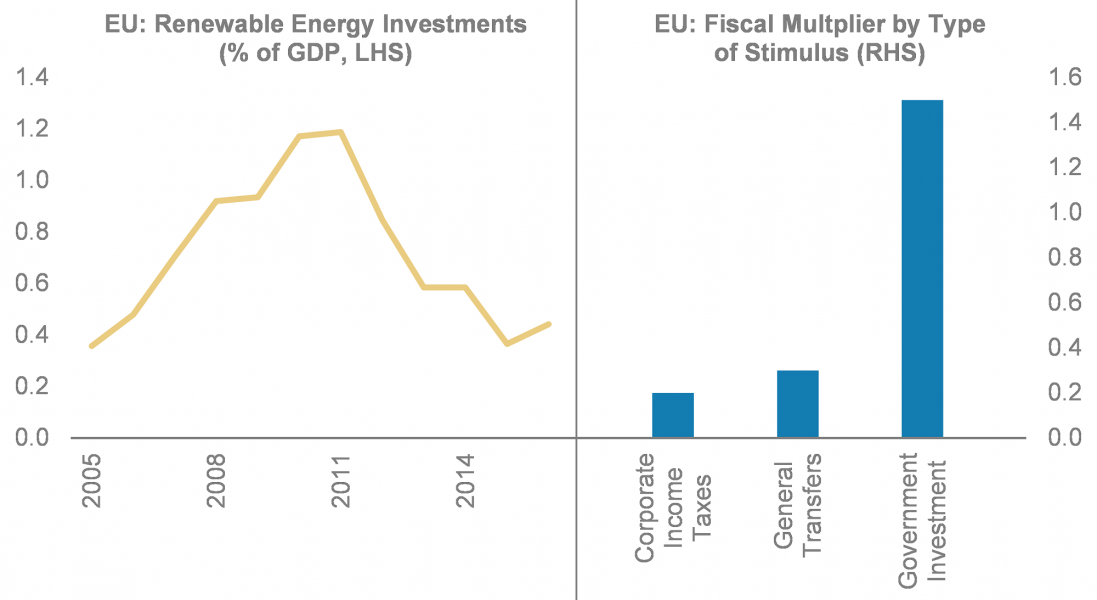
Source: IRENA, Coenen et al. (2012), Morgan Stanley Research estimates
Semi-stagnant Europe: We have a downbeat view on the euro area. Although we do see some upside risks, especially in Germany, in our base case forecast we see growth improving only gradually over time, as trade tensions ease and some modest additional monetary and fiscal stimulus supports growth. Against this backdrop of modest growth, we expect inflation to hold below target through the forecast period. In this situation, we see a strong case for policies that support growth moving back to trend and inflation back to target.
Monetary policy | Out of ammunition: We see limited scope for the current set of monetary policy tools to reflate the economy and provide a significant boost to growth, since we see limited scope to cut rates further and limited impact from lower rates and additional asset purchases. While there are more radical options available, such as incentivising banks to lend more aggressively and financing individual accounts, we see legal, political and operational constraints to their implementation.
Fiscal policy | Facing roadblocks: This looks challenging: many euro area countries do not have the ability in the current fiscal framework to add fiscal stimulus, agreement on meaningful euro-level fiscal capacity looks still far off, and the surplus countries with headroom, principally Germany, while they are financing some modest incremental easing – 0.4pp of euro area GDP – appear unwilling to add further fiscal stimulus.
Extra fiscal stimulus could be an option for breaking out of stagflation… Broadly aligned with our call, the euro area appears to have stabilised, while some survey data are starting to point to some pick-up in the course of this year. With a likely small impact from the latest ECB package, the potential for a fast recovery in the euro area, lacking a strong and harmonised global recovery, is linked to a more active role from fiscal policy, we think. Without sizeable fiscal capacity at the European level so far, fiscal policy remains mostly driven by national policy.
…but hard to see where it would come from: As a broad generalisation, those with the capacity to act – notably the core countries such as Germany and the Netherlands with debt below 60% of GDP and currently running surpluses – have been unwilling to act, since they are at full employment and are reluctant to add stimulus at this point in the cycle. And conversely, those that might like to act – the more heavily indebted economies with stillhigh levels of unemployment – do not have the fiscal space, with debt over 60% of GDP and limited headroom, even against the 3% of GDP deficit reference criteria, let alone against their more challenging medium-term budgetary objectives.
Greenflation… We think the renewed political commitment to tackling climate change is likely to lead to an increase in government spending and in investment, both public sector and private sector, which could have a positive impact on growth. This possibility is illustrated by the Commission’s ambitious Green New Deal – which seeks to mobilise €1 trillion to support decarbonisation over 10 years – which may have a direct impact on growth through a higher proportion of capital investment, and an indirect impact through supporting a higher level of spending and investment from national budgets and the private sector.
| Steady progress in decarbonising the EU energy supply… | …but a step change now needed to hit the carbon target |
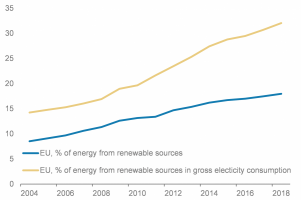 |
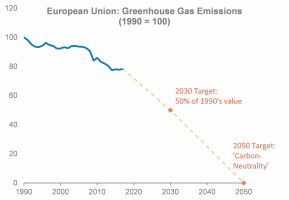 |
| Source: Eurostat, Morgan Stanley Research | Source: European Environment Agency, European Commission, Morgan Stanley Research |
…or greenstagnation? There is a strand of environmentalist thinking that is suspicious of growth, amid concerns that it is destructive of the environment. In line with this thinking, some advocate achieving greener outcomes more through higher taxes and regulation, and less through greater public spending. Although regulation can drive green investment – as appears to be happening in the automotive industry with lower emission standards helping to drive electrification – this usually requires the right policy mix, with support from some additional government spending, e.g., on supporting R&D and financing the new infrastructure for electric vehicles. We see two high-level risks with a regulation and taxation-led approach to decarbonisation: first, it might deter investment and hit growth, reinforcing stagnation; second, it could create more barriers to trade, which could be a risk for a trade-dependent European economy, if increased production costs in Europe due to more expensive energy required permanent border adjustments (taxes on imports, subsidies on exports) to protect EU industry. At the sectoral level, energy intensive industries such as steel, chemicals and cement could be particularly impacted by differentially higher EU green taxation, carbon pricing and environmental regulation, and might then be at risk of relocation to jurisdictions with lower energy costs.
| Euro area growth projected to stay weak in coming quarters | Impact of QE declining over time |
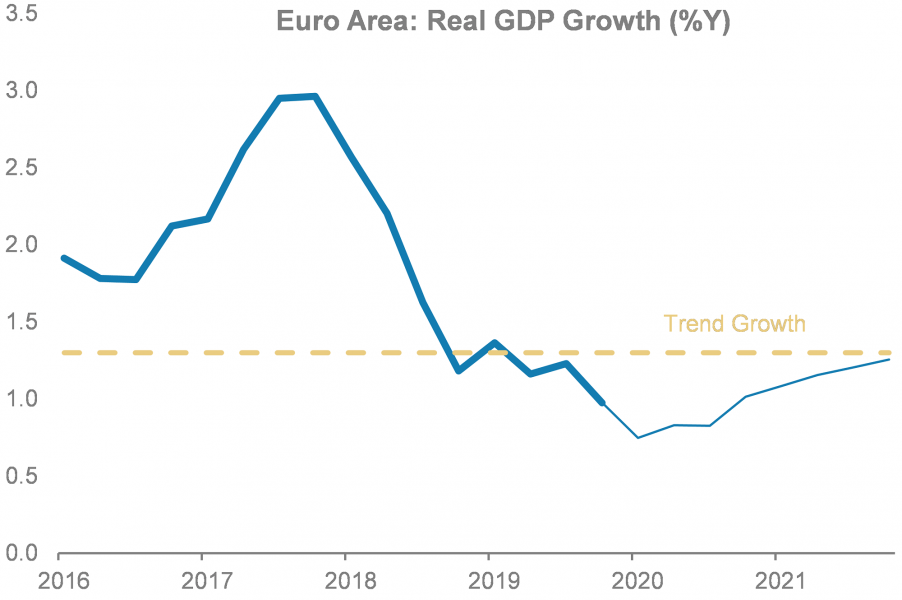 |
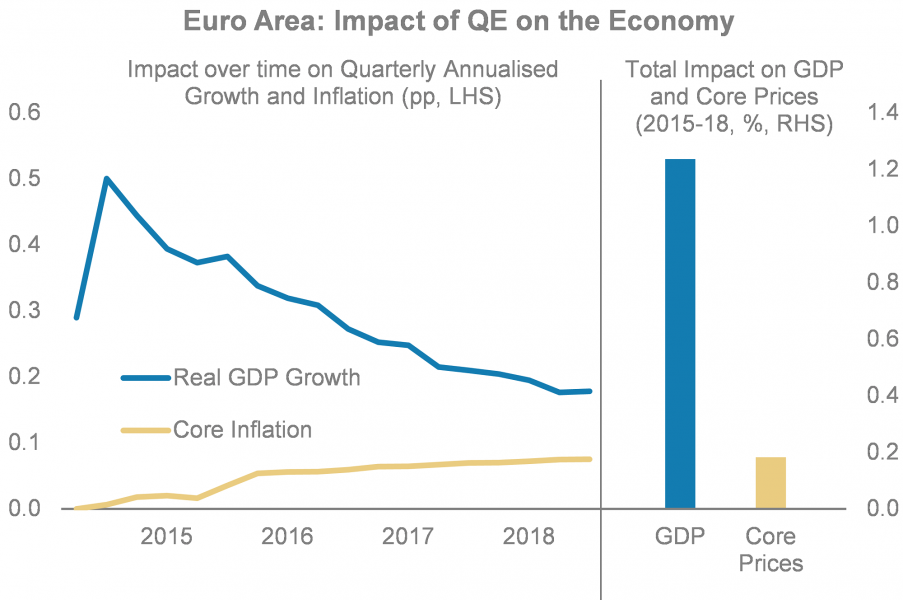 |
| Source: Eurostat, Morgan Stanley Research; Note: Thin line = Morgan Stanley forecast | Source: Morgan Stanley Research estimates |
| Only modest fiscal stimulus so far… | …though more public investment could drive a sharper pick-up |
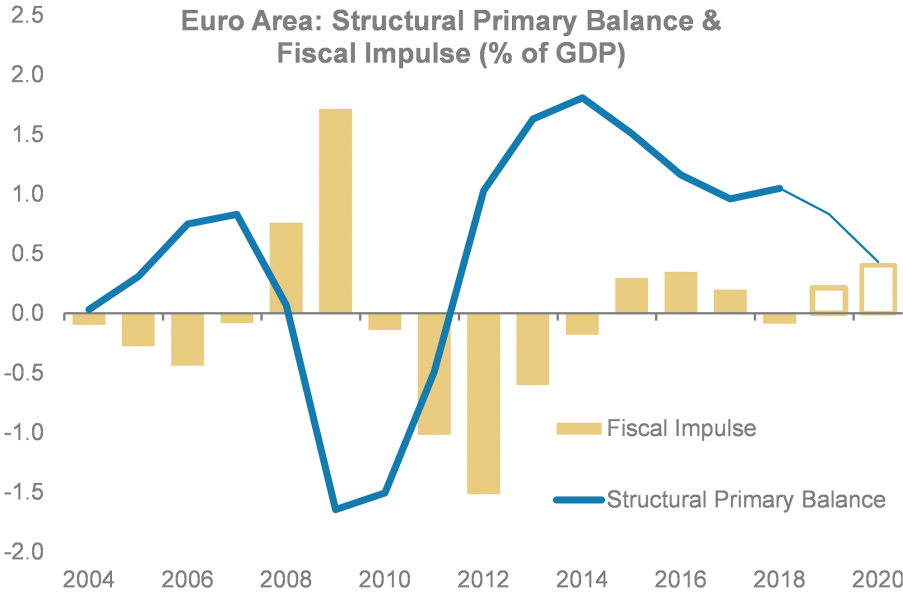 |
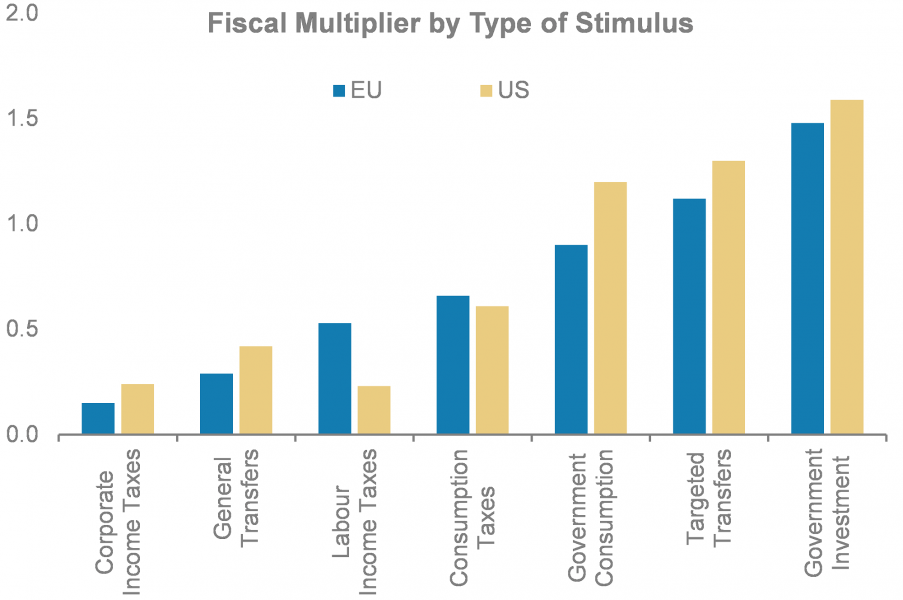 |
| Source: European Commission, Morgan Stanley Research; Note: Empty bars, thin line = Morgan Stanley forecast; Structural primary balance = cyclically adjusted primary balance ex oneoffs; Fiscal impulse = change in structural primary balance; +/- = fiscal boost/drag. |
Source: Coenen et al. (2012), Morgan Stanley Research |
| We think government guarantees could provide some fiscal space… | …against a backdrop of broad public support for action on climate change |
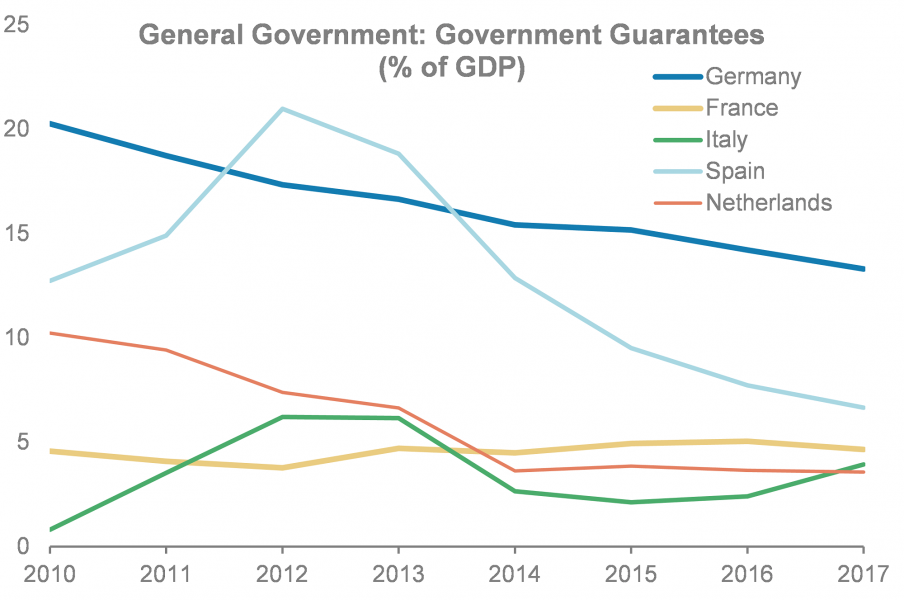 |
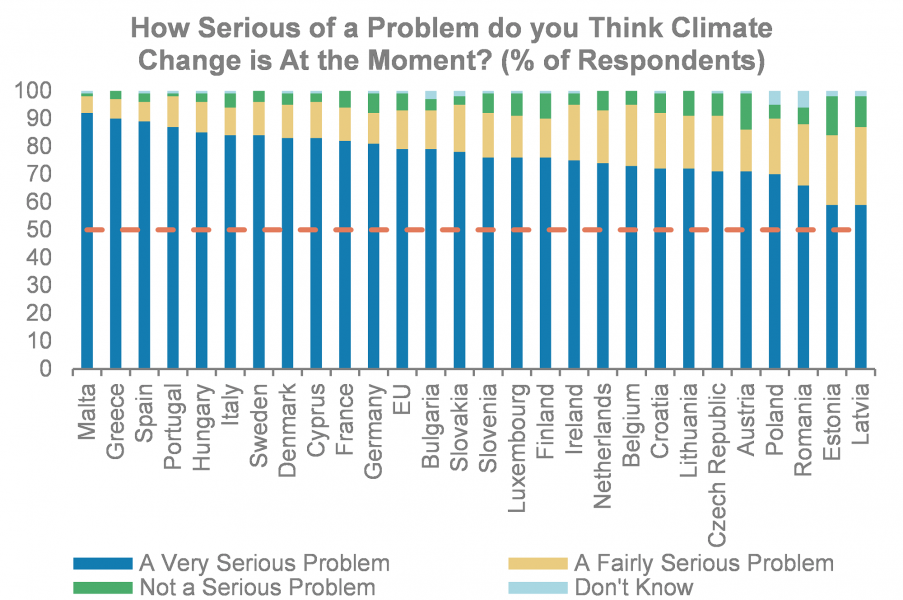 |
| Source: Eurostat, Morgan Stanley Research | Source: European Commission, Morgan Stanley Research |
Greenflation options: We take a more detailed look at four of the more plausible options for greenflation, i.e., green fiscal stimulus. Our preliminary assessment is that we are unlikely to see a shift to the European fiscal framework, or ECB action taking a lead. However, we do see some chance of a greening of German politics driving a national green stimulus in the euro area’s largest economy. The other plausible pathway for “greenflation” looks to us to be increased use of government guarantees to support an accelerated roll-out of green technologies – notably onshore wind, offshore wind and solar PV – by the private sector, as proposed as part of the Commission’s Green New Deal.
Energy – across power and transport – is the focus: Decarbonising the economy will require fundamental change in many sectors. However, two sectors stand out. First, the use of fossil fuels accounts for 54% of all emissions. In other words, replacing fossil fuels with decarbonised fuel or power would reduce carbon emissions by more than half. Second, since transport accounts for a further 25% of emissions, decarbonising transport would reduce carbon emissions by a further quarter. The central role of energy in decarbonisation was recognised by the Commission’s assessment that “the production and use of energy… account for more than 75% of the EU’s greenhouse gas emissions”. Moreover, both these tasks now look achievable: new renewables are broadly already cost competitive with traditional fossil-fuel power generation, while many experts, including Morgan Stanley analysts, think that EVs will achieve cost parity with ICEs around 2025.
We discuss these options in turn.
One common proposal for how to support additional investment in reducing carbon emissions is adjustments to the fiscal framework to allow additional government borrowing to invest in green projects. This could take the form of exempting investment on green projects from the reference criteria of a 3% deficit or a 60% level of debt, e.g., by allowing a further 1% of GDP in investment on qualifying green projects, and an additional amount – perhaps 5% of GDP – green debt.
“Borrowing to invest” option: With historically low borrowing costs, some see an opportunity to fund increased borrowing, particularly for one-offs, such as public investment projects, rather than for recurrent spending. For instance, the UK has moved to increasing the permissible level of net public investment from 2 to 3% of GDP, while debt service costs are under 6% of government spending. With the majority of euro area bonds in negative yield territory, governments can borrow for free, which will enhance the return on any public investment with a positive return.
| Borrowing has never been cheaper… | …yet public investment remains low |
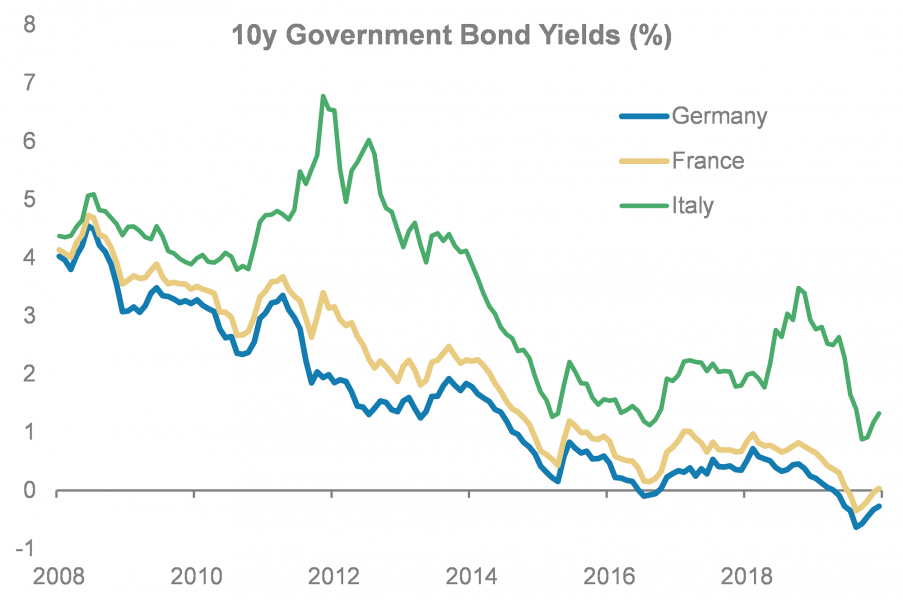 |
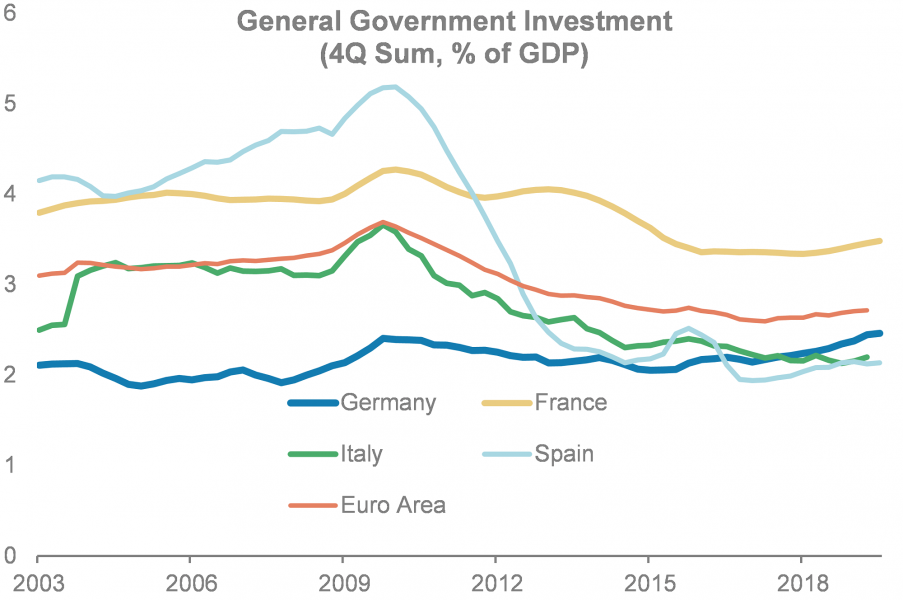 |
| Source: Tullet Prebon, Morgan Stanley Research | Source: Eurostat, Destatis, Insee, INE, Morgan Stanley Research |
Objections: However, we see three objections to such a proposal, which cumulatively makes it implausible, we think:
Active debate on excluding green measures from the fiscal rules
Review of fiscal framework: The European Commission is set to release a report on the so-called six-pack and two-pack legislative packages – which overhauled the fiscal rules during the euro crisis – in early February. In parallel, the Commission is also launching a review of the Stability and Growth Pact, and plans to make legislative proposals by the end of 1H-20. Paolo Gentiloni, the European Commissioner for Economic Affairs, has suggested easing the fiscal rules, leaving open the possibility of reforming the system in a way that could allow additional green investment. But, European Commission Vice-President for the Economy Dombrovskis sounded more cautious in December, adding that the goal of the review is to simplify and streamline the rules, avoiding divisive debates.
No consensus on green exclusions: We found significant pushback against the idea of excluding green spending from deficit calculations. For instance, Eckhardt Rehberg, the senior budget spokesman for Chancellor Angela Merkel’s CDU, said that “We don’t need any more exceptions”, while Hans Michelbach, an MP for the CSU, the CDU’s sister party, and the party’s main spokesman on budget matters, argued that “Gentiloni’s plans are an attack on the stabilisation goals under the pretext of protecting the climate.” More recently, while talking about exclusion for green measures, Austria’s Finance Minister Blümel noted that “the idea of the Stability and Growth Pact was well conceived but euro (zone) countries have too often not stuck to it. New exceptions should therefore not be defined but rather the penalties for breaches should be increased”.
| Some improvement: A majority of member states meet the 60% of GDP debt criteria… | …and in 2018 only one member state had a deficit above 3% of GDP |
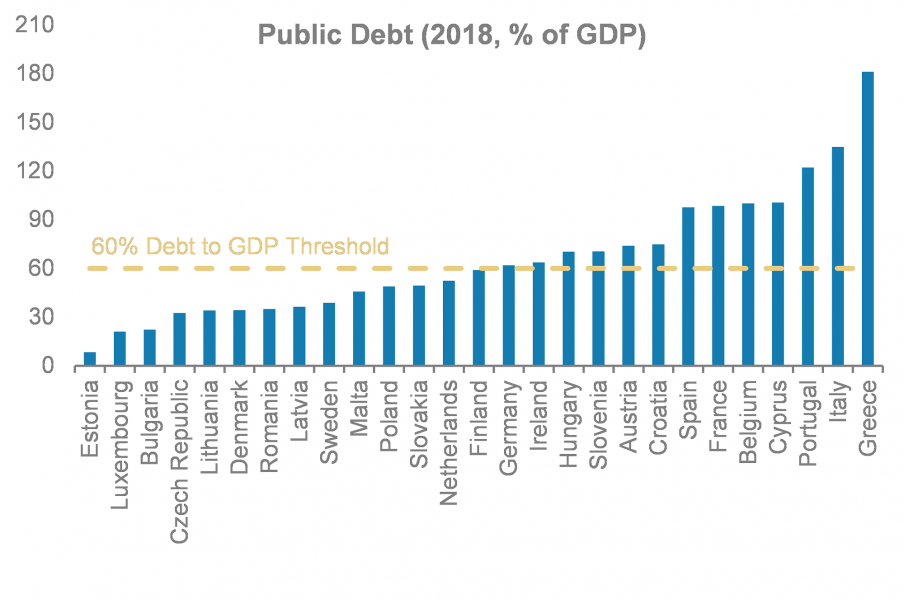 |
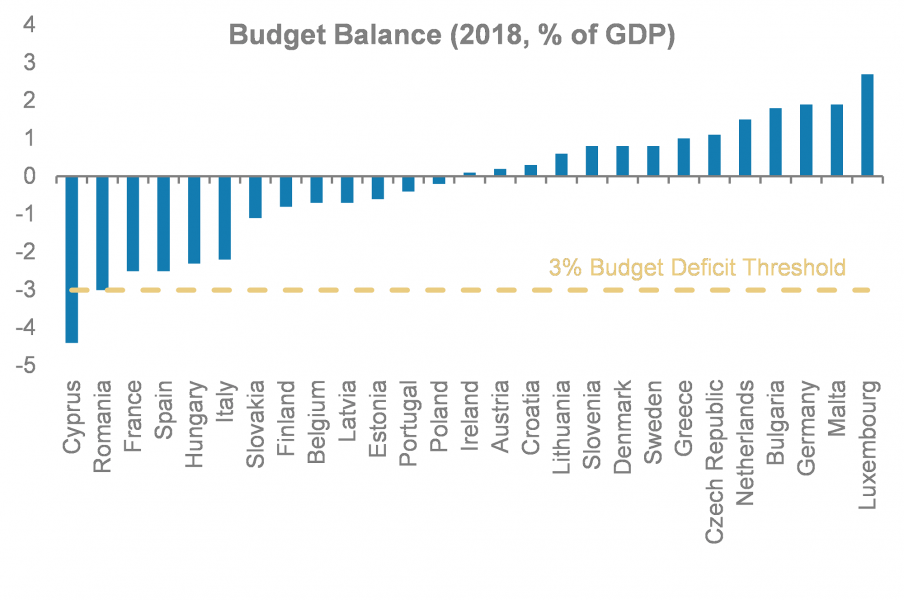 |
| Source: Eurostat, Morgan Stanley Research | Source: Eurostat, Morgan Stanley Research |
A second common proposal is for the ECB to lead the policy effort, much as the ECB has done the heavy lifting in tackling the risk of deflation in the euro area through large scale and innovative policies. Moreover, the central bankers seem to be open to playing a role, with the establishment of the Network for Greening the Financial System. For instance, a major recent BIS report (“The green swan“) set out ways in which central banks can contribute to tackling climate change. Similarly, the ECB review will consider what can be done to support objectives beyond price stability, including sustainability, while President Lagarde has said she would support doing whatever she could within the ECB’s mandate to reduce carbon emissions and support biodiversity.
Green QE, or green regulation? We see two main tools the ECB can use to promote green policies. First, it can discriminate in its asset purchases between green and “brown” bonds, and preferentially buy green bonds and refuse to buy brown bonds, which would in theory lower the cost of financing green projects by making green bonds cheaper to issue. However, in practice we see limited impact from green QE, since the eligible green bond universe is quite modest (€63 bn, on one estimate) and EU has already bought a significant proportion of the outstanding issue. Second, we think the EU can as a supervisor require that the banks under its supervision – 117 banks with approximately €20 trillion in assets – have properly assessed the risks of climate change, which could increase the risk of extreme weather events, and the risks of a sudden transition, which could suddenly and dramatically reduce the value of hydrocarbon assets. Given the lack of green assets to buy, and the ability of stress tests and other regulatory interventions to change the risk assessment of an enormous volume of green and hydrocarbon assets, we see this second tool – regulatory intervention – as likely to have more of an impact over time.
Constraints on the technocrats: While we see central banks as able to play a useful ancillary role and to chivvy the financial sector to take climate risks more seriously, we doubt that they can play a leading role, for two main reasons. First, they have a core mandate which is price stability, and limited legitimacy in tackling issues not directly related to their core mandate. Second, the decisions on how to combat climate change will create winners and losers, and are in many respects political and distributional questions, which require political authority – which unelected technocrats such as central bankers lack – to resolve.
Going green for growth? Thirdly, we think that there is a significant chance of a green shift in German politics. This can be seen in the strong polling for the Greens, which points to a significant risk that they either enter the next coalition or that some of their policies are adopted by the next government. While the current coalition government of CDU/CSU and SPD has recently agreed an ambitious climate package and a record €43bn of investment spending in the 2020 budget, we see potential for a further increase. Under the Stability and Growth Pact, Germany still has ample fiscal headroom to increase public spending, and the Greens are proposing, among other measures, to spend an additional 1% of GDP on long-term investments, including environmental projects such as re-forestation. While there is only limited detail on the exact composition of the spending, it seems that only part of this would be classic high-multiplier (1.5x) investment, which implies a lower overall multiplier of perhaps 0.8-0.9x. 1% of GDP in additional spending on these assumptions would still have a material impact, increasing German growth by ~80-90bps, and euro area growth by around 23-26bps (see box for more details on Green policies) as the increase in spending was implemented.
A selection of green fiscal policy proposals
The German Green co-leader Habeck has proposed a federal investment fund of approximately €35bn p.a. (or 1% of GDP) financed with new debt, which could focus on investment in infrastructure, re-forestation, and the transformation of agriculture. This would require loosening the German “debt brake” – the national rule that federal deficit financing should not exceed a structurally adjusted 0.35% of GDP – to allow a higher level of borrowing for investment in line with the less restrictive Fiscal Compact, which allows Germany a structural deficit of up to 1% of GDP. In addition, he favours a binding rule stipulating that investment at least makes up for depreciation of public assets, and grows in line with GDP. A recent policy success has furthermore been increasing the price of CO2 from €10 to €25 per ton when the new carbon trading scheme commences next year.
But obstacles ahead: However, we also see several obstacles to this outcome. First, there is politics. It is a long way before a proposal from a Green leader becomes Green party policy, and much further still before it becomes government policy. With elections scheduled for autumn 2021, it might be as late as 2023 before any green shift in Germany, if it ever happens. Second, Greens can at times put more emphasis on higher taxation and regulation as a way of incentivising a more rapid energy transition rather than additional public investment – an approach which could hit rather than support growth. Third, significant additional fiscal stimulus in Germany would require modifying the constitutional commitment to avoiding a deficit (the “debt brake”), which in turn would require a two-thirds majority in both chambers of parliament, which makes it significantly harder to achieve.
| German polling: Greens in stable second place | German fiscal policy space – in contrast to most major euro area economies |
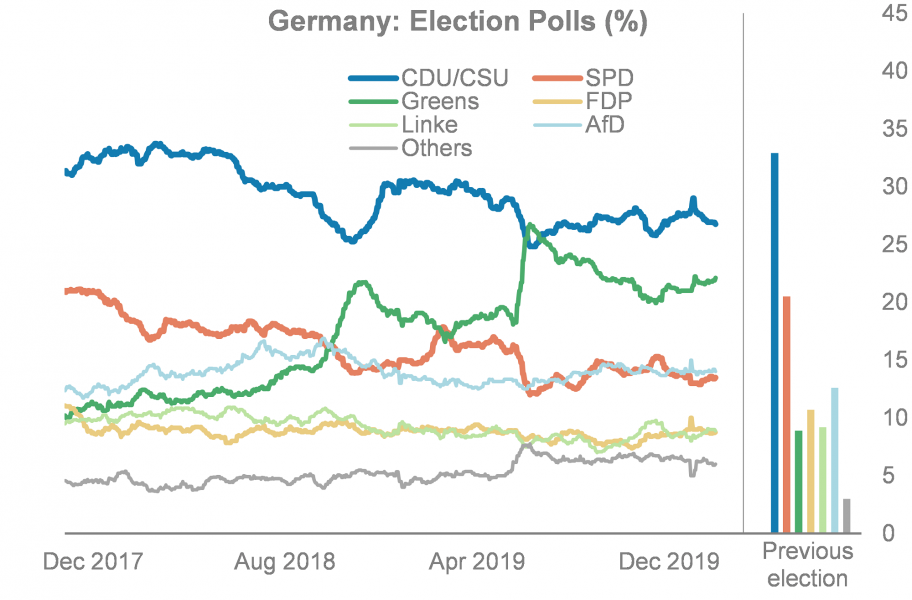 |
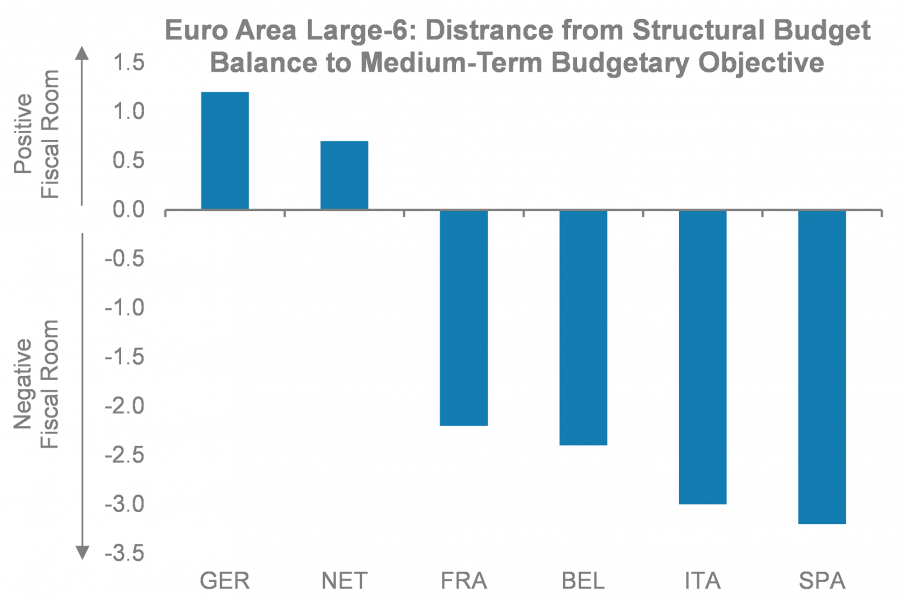 |
| Source: Opinion polls, Morgan Stanley Research | Source: European Commission, Morgan Stanley Research |
Guarantees | Facilitating stimulus without widening the deficit: Fourth, and probably most plausibly, we see expanded use of the public sector balance sheet as an option to support an accelerated expansion of green technologies, and in particular renewable energy. The fundamental change which makes this approach possible is the dramatic decline in the cost of energy from three of the new renewables – onshore wind, solar and now offshore wind – so that they are now broadly cost competitive with fossil fuel power. As a result, the direct fiscal cost of financing a renewable project is now low and can even be negative – as with the contracts in the UK’s 2019 CfD auction, which implied a notional monetary budget gain of £657 mn by 2026/27. In short, the levelised cost of electricity from wind and solar is broadly comparable to the cost of fossil fuel power (“subsidy-free”): for instance recent EU baseload wholesale electricity prices averaged 5.2c/kWh (Q3-19), compared to an average levelised cost of electricity in 2017 from wind at 6c/kWh. However, in the absence of a government guarantee, or some other form of public sector participation, the risk could be too great for a private sector developer to raise debt financing at a level consistent with a commercial project. This then creates the scope for a mutually beneficial deal. The policy maker wants to accelerate decarbonisation without widening the budget deficit, while the developer wants to derisk the project so that it can be financed at a low rate. In principle, provision of a public sector guarantee, e.g. guaranteeing a fixed price of electricity but one at or below the market price of future electricity as in the case of the UK CfD auction.
Only half a free lunch: The impact of “guaranteed greenflation” is constrained. There are limits on the capacity to ramp up deployment of new projects. There could be some direct fiscal costs, since some contingent liabilities could get called, some direct fiscal support will likely be needed to strengthen energy systems to cope with more dispersed and fluctuating sources of power and provide additional storage, and governments will often find themselves stuck with the physical and social costs of decommissioning defunct fossil fuel industries, particularly coal. Nonetheless, we think the emergence of cost competitive renewable technologies provides an unusual opportunity for governments to stimulate private sector investment and growth using contingent guarantees rather than direct subsidies.
| Recent falls in cost have made solar and onshore wind broadly competitive with traditional fossil-fuel generation … | …and now offshore wind looks to have made the same journey down the cost curve |
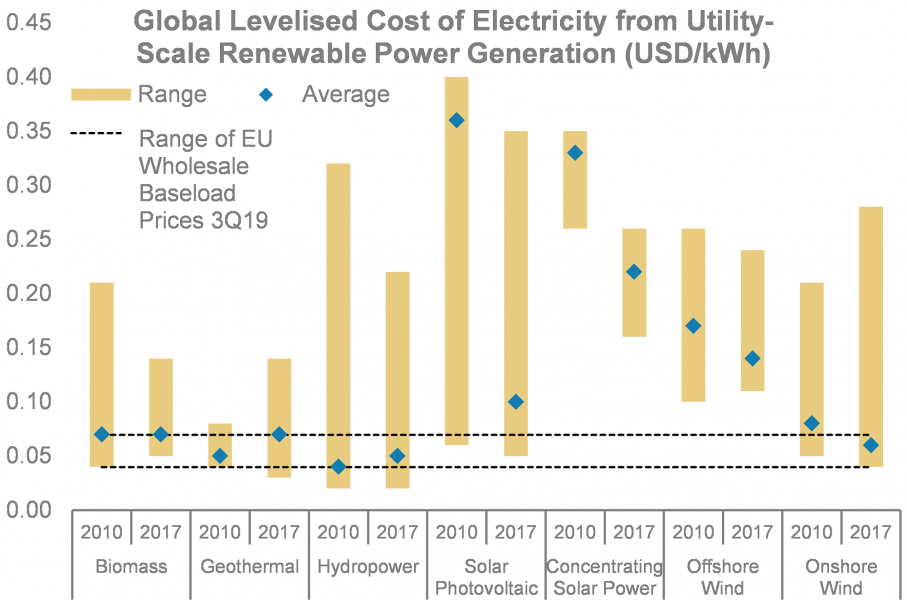 |
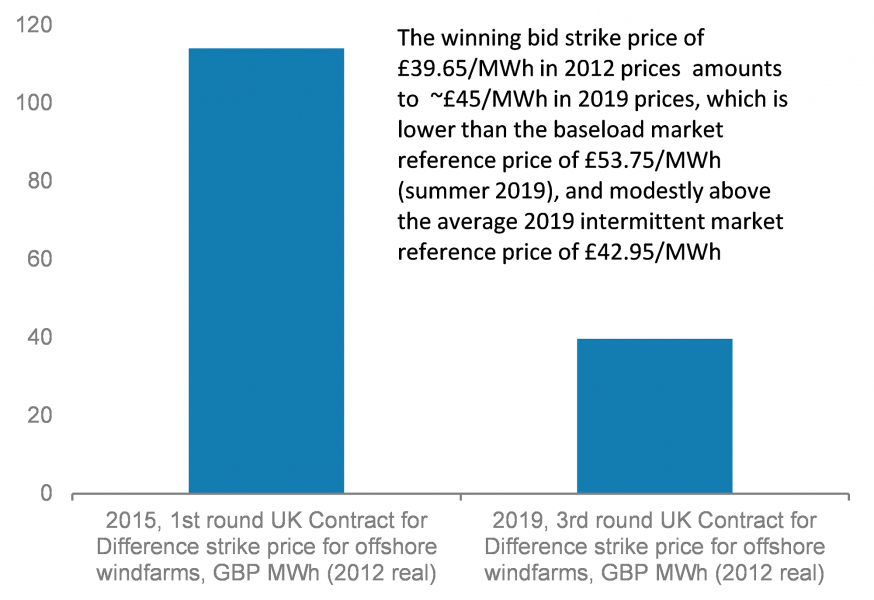 |
| Source: IRENA, European Commission, Morgan Stanley Research | Source: UK BEIS, Morgan Stanley Research |
Capacity constraints? One issue is whether there is the capacity to expand activity meaningfully, in a way which makes a difference to the European growth outlook. We have a couple of high-level reasons for thinking this will be possible. First, the volume of investment and capacity additions is currently lower now than in 2010-12, implying spare capacity in the industry. Second, the industry has a history of responding rapidly, helped by a shorter construction cycle than traditional energy investments, seen eg in 2011 in solar and in 2017 in wind.
| A decline in the level of green investment from the 2010-2012 peak … | …reflected in a decline in the expansion of clean generation capacity |
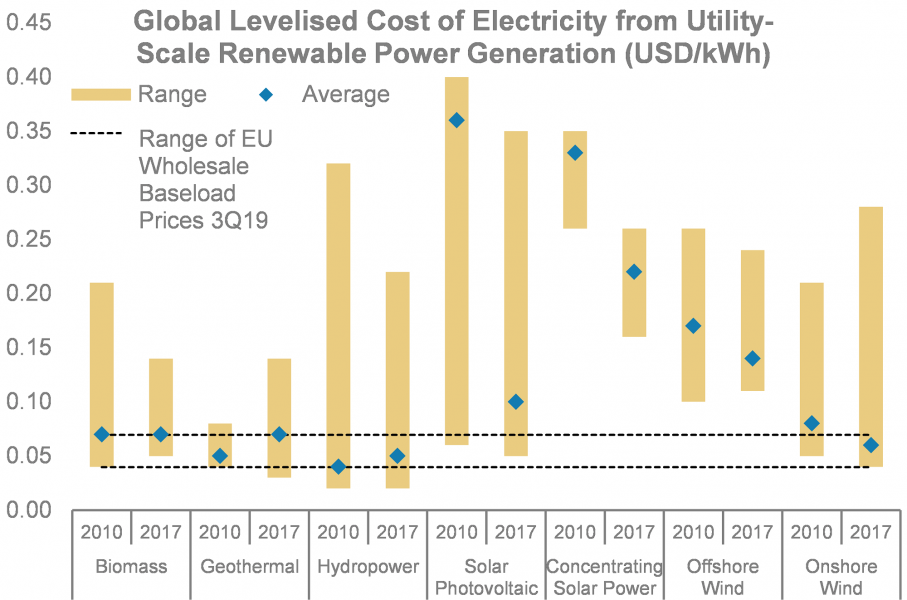 |
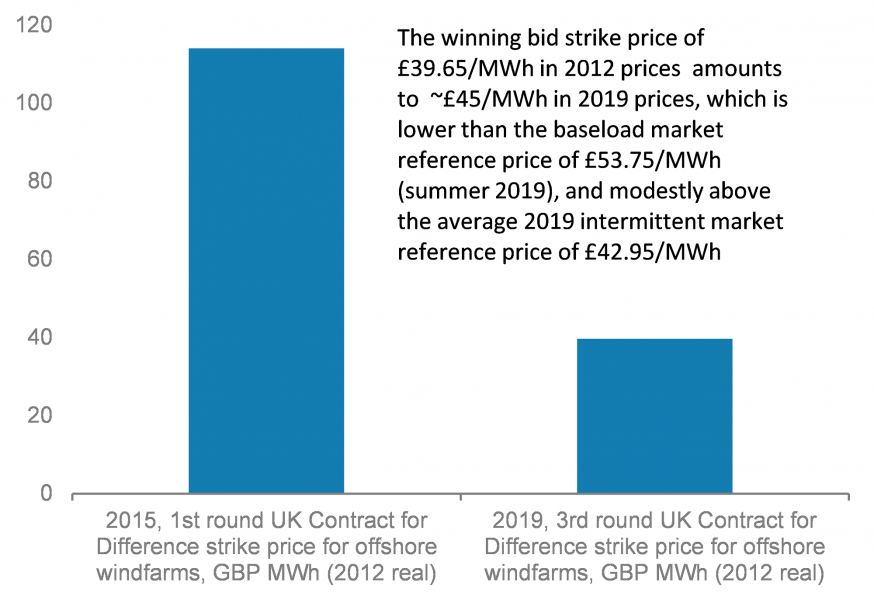 |
| Source: IRENA, Morgan Stanley Research estimates | Source: Windeurope, Solar Power Europe |
Upside risks: Overall, the emerging green push translates into upside risks to growth. But the route to greenflation remains unclear. We are sceptical that the EU will loosen the fiscal framework, or that the ECB can play a leading role. Still, a greener policy is likely to drive higher investment, which has a higher multiplier effect on growth. We see some chance of a greening of German politics, given the popularity of the Greens and the precedent of the nuclear shutdown, which could lead to greater green stimulus, given Germany’s fiscal headroom. However, we see the most likely path to greenflation as being through an expansion in the use of government guarantees to fund renewable energy projects. We think this could have a major impact, now that a broad group of renewable projects – including solar PV and onshore and offshore wind – are commercially viable in many cases without material fiscal subsidy.
What’s the deal with the green deal? The new European Commission (EC) has made climate change one of its top priorities. In December it released its vision of a “European Green Deal” which aims to achieve carbon neutrality in the European Union by 2050, while meeting tighter reductions in emissions by 2030.
Green growth boost of about 200 bps? The EC estimates that to be on track with this target would require €260 billion of additional annual investment (1.9% of EU-27 GDP) over the next ten years, or €2.6 trillion in additional investment. If this were implemented, using a standard multiplier of 1 for investment, this would imply a 200bp boost to EU growth, as investment was ramped up to the new level, of around 200 bps.
The Commission’s more modest plan: The Commission plan – the Sustainable Europe Investment Plan – is significantly more modest. It aims to coordinate €1 trillion over the next ten years, i.e. about €100 bn pa – to fund investments to tackle climate change. To this end, it cobbles funding together, partly from existing sources and partly on the assumption that others will join in. Roughly half is to be funded from the EU’s long-term budget. Meanwhile, national governments are expected to allocate around €114bn to the plan, co-financing projects supported by the EU. In addition, private investors are expected to invest, with around €280bn of investments to be mobilised, using guarantees and the European Investment Bank (EIB). Finally, a so-called “Just Transition Mechanism” (~€143bn), aimed at helping the regions and sectors facing bigger challenges to decarbonise, is to be financed via a complex mix of the EU budget, national budgets and support from the EIB.
The financing sources and components of the Commission’s Green New Deal
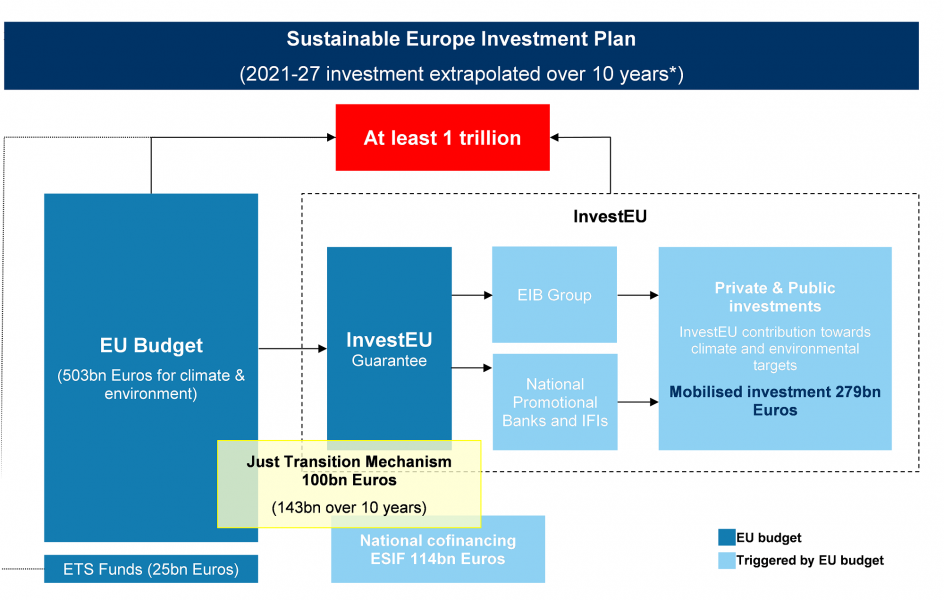
Source: European Commission, Morgan Stanley Research
Just smoke and mirrors? The Green New Deal looks to be almost entirely funded either from existing budgets, apart from a proposed €7.5bn in additional funding for the Just Transition Mechanism, whose funding is itself not yet clear, or from other sources, notably national budgets and the private sector, whose participation is not under the control of the Commission. So it is still just a draft plan, and it is not yet clear if the crucial detail of the proposals will be supported in capitals and at the EU Parliament.
We see a modest green fiscal boost: Despite these caveats, we see an upside risk to growth from the green new deal, which we provisionally size at around 25bp of EU GDP, from two sources:
a) a shift in the composition of public sector spending to an increased proportion of investment, which has a higher multiplier than current spending (about 10 bp);
b) an increase in private sector investment, through use of guarantee and other mechanisms for public sector participation to de-risk projects, particularly renewable energy projects which are now broadly cost-competitive with fossil fuel comparators and do not require sizeable fiscal subsidy (about 15bp).
We would expect this impact to start in 2021, with the start of the new budgetary period, but plan to wait for more detail on the financing and timing before building this upside risk into our forecast.
The Green New Deal could deliver a 25bp boost to growth, we think, on prudent assumptions
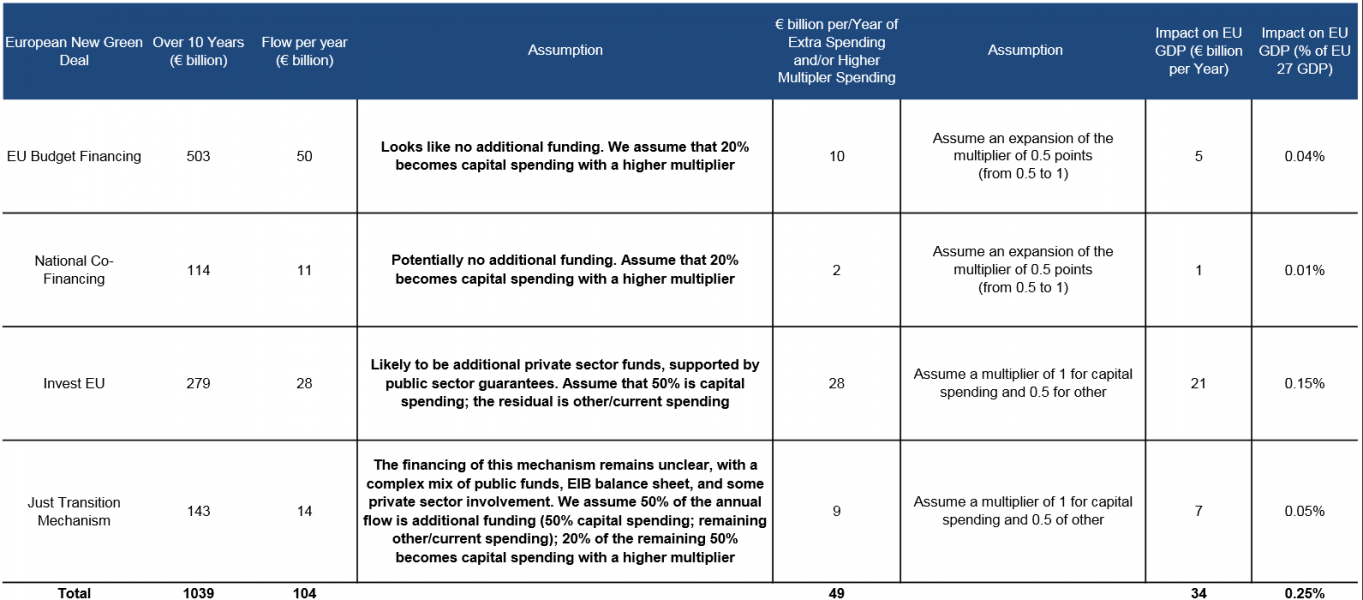
Source: Morgan Stanley Research
‘Green stimulus’ has a chance… The various European institutions appear committed to tackling climate change, with the European Commission’s Green Deal an example of this drive. But “greenflation” doesn’t come without fiscal challenges. Many euro area countries do not have the ability in the current fiscal framework to add fiscal stimulus, agreement on meaningful euro-level fiscal capacity still seems far off, and the surplus countries with headroom, principally Germany, look unwilling at this stage to adopt a major fiscal boost. In this report, we have looked at four potential pathways for “greenflation”.
…with the use of government guarantees likely to prove key: Our preliminary assessment is that we are unlikely to see a shift to the European fiscal framework, or ECB action taking a lead. Instead, we do see some chance of a greening of German politics driving a national green stimulus in the euro area’s largest economy. The other plausible pathway for “greenflation” looks to us to be increased use of government guarantees to support an accelerated roll-out of green technologies – notably onshore wind, offshore wind and solar PV – by the private sector, as proposed as part of the Commission”s Green New Deal.
This article is based on research published for Morgan Stanley Research on January 31, 2020. It is not an offer to buy or sell any security/instruments or to participate in a trading strategy. For important current disclosures that pertain to Morgan Stanley, please refer to Morgan Stanley’s disclosure website: https://www.morganstanley.com/eqr/disclosures/webapp/generalresearch . Copyright 2020 Morgan Stanley.